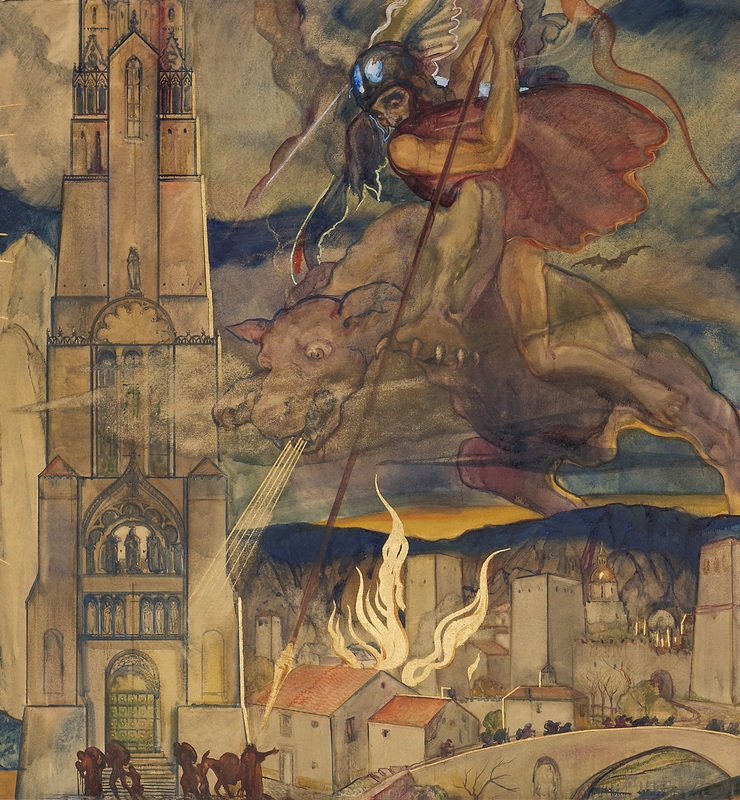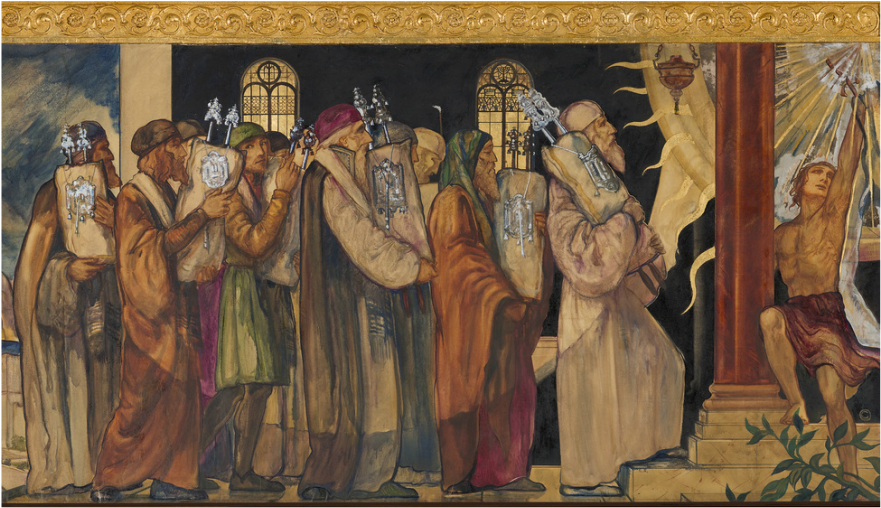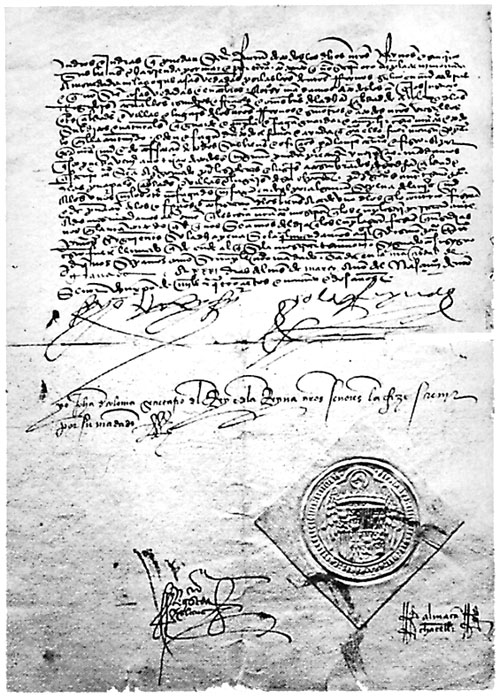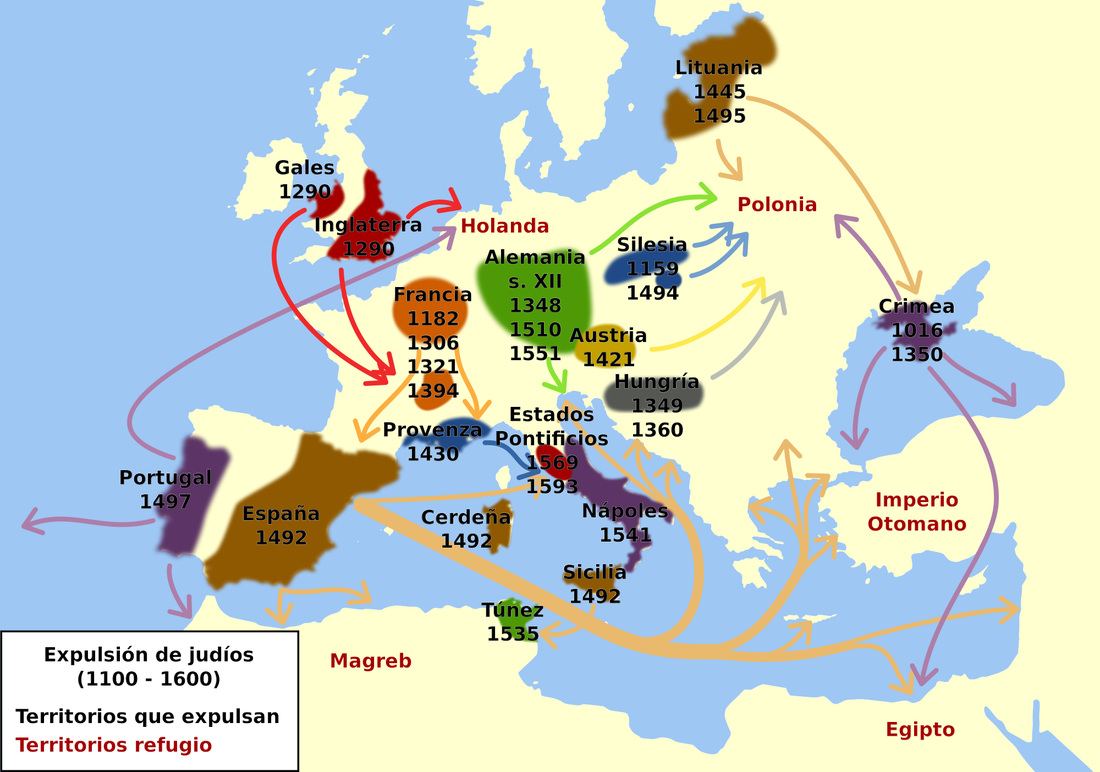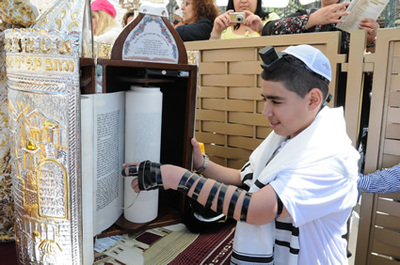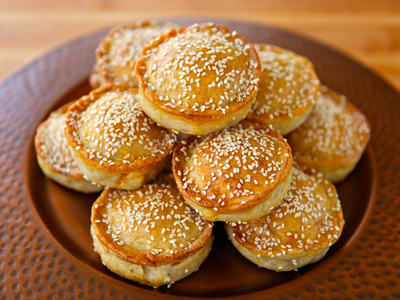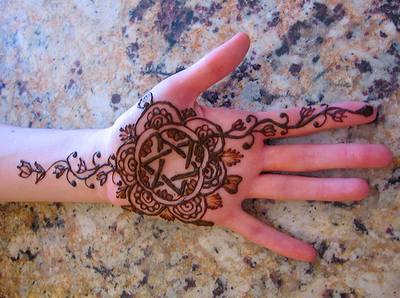Curriculum Track #1: Time Traveling Through Jewish History
Journey #11: Inquisition and Exile
Mural Description From the Lectures of Rabbi Edgar F. Magnin, 1929-1930: "Inquisition. A cathedral tower and a portal. Figure of terror in the sky riding upon a gruesome beast which breathes fire. He is pointing his destructive lance toward the Jews who are being driven out of the town and crossing a bridge on their journey over the world. Their houses are burning."
The Processional. "Jews in Spain removing the Torah Scrolls from the Ark, getting ready for their journey out of the country. The light shines through the Synagogue windows. The everlasting lamp hangs in front of the Ark.
This picture typifies the exile of the Jews from country to country and particularly from Spain in 1492. Wherever the Jews wandered they carried the Torah with them in their arms and in their hearts. Figure of Youth with arm outstretched, hand holding a wand from which light radiates. He typifies hope for the future."
This picture typifies the exile of the Jews from country to country and particularly from Spain in 1492. Wherever the Jews wandered they carried the Torah with them in their arms and in their hearts. Figure of Youth with arm outstretched, hand holding a wand from which light radiates. He typifies hope for the future."
Read in Primary Text: Understanding Jewish History 1, Sol Scharfstein, Ktav, 1996. The Marranos, The Inquisition, pages 154-155; The Expulsion from Spain pages 156-157
Enduring Understandings:
- In later Medieval times Christian rulers increasingly dominated the region; they sought to strengthen their power by demanding non-Christians convert or ultimately be killed.
- Many Jews that converted upon force of death, secretly practiced Judaism and identified as Jews.
- The expulsion of the Jews from Spain and other countries from 1492 onward set in motion a migration of Jews across the globe that impacted where many of our Jewish families live today.
- Why did the new rulers insist that minorities convert to their faith when they conquered Spain?
- What are the different reasons some Jewish families converted, and others did not, when facing persecution during the Inquisition?
- How did the expulsion, and subsequent migration of Jews, impact the Jewish world we live in today?
Ideas to Discuss
- During what has been called the "Jewish Golden Age" in Spain between the early 10th and 13th centuries, Moslems controlled the Iberian Peninsula and Jews, Christians and Moslems lived together in what some historians called convivencia--a complicated, up and down kind of coexistence. They sang each other's songs, imitated each other's poetry, played each other's games, especially the Muslim introduced game of chess, learned new ideas about science, medicine and astronomy from each other, and enjoyed each other's traditional styles of cooking. But toward the end of the 14th century this spirit of convivencia began to unravel.
- Christian Spain was divided into two kingdoms: Aragon and Castile. As the Christian Kings ruling the Northern parts of Spain gained strength, they reconquered the Southern regions ruled by the Muslim Moors. The Spanish Jews were seen as a threat to the newly solidified Christian Spain. For first time they were singled out and forced to wear a yellow star. They were given a choice: convert to Christianity or be put to death.
- In 1391 Christian mobs burned Jewish towns; 100,000 Spanish Jews chose forcible conversion over death. The New Christians were called Conversos or Marranos--which means "Pigs." The "Old Christians" distrusted them and saw them as competitors now that they could work in professions that were previously off-limits to Jews.
- Many of the conversos who converted under force secretly practiced Judaism. They were known as "Crypto (secret) Jews." They attended Church and baptized their children, but behind closed doors they lit Shabbat candles, refused to eat non-kosher foods, baked matzoh for Passover and kept Jewish rituals quietly alive. During this time the persecuted Jewish community lived side by side with the conversos --who were sometimes members of the same family, even though by 1411 there were laws to keep them apart.
- In 1469 Isabella of Castille and Ferdinand the II of Aragon married and the two great kingdoms of Spain merged into a great and cruel Christian power. At first the Christian Church accepted the conversos equally but as rumors spread that many conversos were secretly practicing Judaism, Queen Isabella established the Inquisition in Spain--a court established by the Church responsible for finding and punishing people who did not accept its beliefs and practices. Anyone suspected of secretly practicing Judaism was arrested, forced to confess and cruelly and publicly executed.
- Queen Isabella and King Ferdinand came to realize that the conversos would never fully embrace Christianity while Jews were still living and practicing their religion in Spain. They believed this was causing the new converts to "backslide" to their old beliefs. On March 31, 1492 the Edict of the Expulsion of the Jews was made public. It was met with disbelief and despair. Jews who had lived in Spain for generations were given four months to sell their belongings and leave.
- The most fortunate of of the exiles were those that settled in Turkey, where they were warmly welcomed and seen as an asset to the economy. Others ended up in North Africa, Italy, Greece and elsewhere throughout Europe and the Arab world, and were known as Sephardim — Sefarad being the Hebrew name for Spain. After the expulsion, and because of what was felt as a terrible betrayal, the Sephardim imposed an informal ban forbidding Jews from ever again living in Spain.
The Edict of Expulsion of the Jews
Written by King Ferdinand and Queen Isabella of Spain, dated March 31, 1492
The Edict, also known as the Alhambra Decree, went public during the week of April 29, 1492. The charter declared that no Jews were permitted to remain within the Spanish kingdom, and Jews who wished to convert was welcome to stay. Whether a Jew was rich or or poor did not matter, they all still had to convert or leave. Spain was not the only country who expelled Jews at this time. See the map below for the countries and years where Jews were expelled from the communities they had lived in for generations.
Written by King Ferdinand and Queen Isabella of Spain, dated March 31, 1492
The Edict, also known as the Alhambra Decree, went public during the week of April 29, 1492. The charter declared that no Jews were permitted to remain within the Spanish kingdom, and Jews who wished to convert was welcome to stay. Whether a Jew was rich or or poor did not matter, they all still had to convert or leave. Spain was not the only country who expelled Jews at this time. See the map below for the countries and years where Jews were expelled from the communities they had lived in for generations.
Activity #1 Mapping Expulsion
The map above is written in Spanish. Open Google translate. As you review the map together take turns typing in the names of the countries in Spanish to see what countries are written here. The letters in black are the different European countries the Jews were expelled FROM and the year they were expelled between 1100-1600. Red letters show the counties where expelled Jews fled TO. As you can see Spain was not the only European country to expel the Jewish community during this time.
The map above is written in Spanish. Open Google translate. As you review the map together take turns typing in the names of the countries in Spanish to see what countries are written here. The letters in black are the different European countries the Jews were expelled FROM and the year they were expelled between 1100-1600. Red letters show the counties where expelled Jews fled TO. As you can see Spain was not the only European country to expel the Jewish community during this time.
Activity #2 Sephardic Traditions Today
If we journey back to the when the Second Temple Jews were were exiled to Babylon (in what is now modern Iraq), we can trace the route of our Biblical Jewish ancestors to when they arrived in Spain and North Africa. After the Expulsion in 1492 the Jewish journey began again, as families packed the few heirlooms they didn't have to sell or abandon, kept their Jewish traditions and memories close to their hearts, and migrated eastwards towards Turkey and the Ottomon Empire, or towards Western and Eastern Europe. Some eventually arrived in the Americas.
In this project students will learn about, and present, some of the unique and enduring traditions that remain a part of Sephardic Jewish life. Sephardim today are considered Jews from Spain, North Africa and Islamic countries who share a common liturgy (style of prayer) and customs which are different from Ashkenazi Jews who settled in Eastern and Western Europe. Whatever country our Jewish ancestors come from, there are unique traditions including recipes, proverbs, songs, languages, styles of dress and traditional forms of Jewish art.
If we journey back to the when the Second Temple Jews were were exiled to Babylon (in what is now modern Iraq), we can trace the route of our Biblical Jewish ancestors to when they arrived in Spain and North Africa. After the Expulsion in 1492 the Jewish journey began again, as families packed the few heirlooms they didn't have to sell or abandon, kept their Jewish traditions and memories close to their hearts, and migrated eastwards towards Turkey and the Ottomon Empire, or towards Western and Eastern Europe. Some eventually arrived in the Americas.
In this project students will learn about, and present, some of the unique and enduring traditions that remain a part of Sephardic Jewish life. Sephardim today are considered Jews from Spain, North Africa and Islamic countries who share a common liturgy (style of prayer) and customs which are different from Ashkenazi Jews who settled in Eastern and Western Europe. Whatever country our Jewish ancestors come from, there are unique traditions including recipes, proverbs, songs, languages, styles of dress and traditional forms of Jewish art.
- Using your ipads and a multimedia or slide presentation app of their choice, (e.g.Keynote, Glogster, Haiku, etc.) students will work in triads to create a 3 minute ipad presentation featuring a Sephardic cultural tradition.
- Each triad will select one of the topics below. Click on the blue words below to link to a resource to get started on the research. Find one or two more sites or books for additional information.
- After the presentation reflect with the class: how are these traditions the same or different than the way your family observes Jewish life?
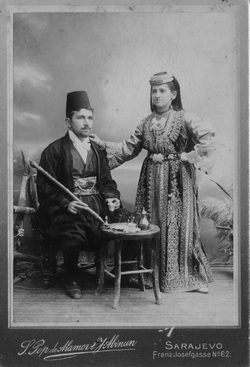 Sephardic Jews in traditional clothing in Sarajevo. 1900. Source Unknown.
Sephardic Jews in traditional clothing in Sarajevo. 1900. Source Unknown.
TRADITIONS TO RESEARCH
Recipes
Passover Traditions
Shabbat
B'nei Mitzvah
Wedding Traditions
Ladino Language
Music and Songs
Proverbs and Stories
Recipes
Passover Traditions
Shabbat
B'nei Mitzvah
Wedding Traditions
Ladino Language
Music and Songs
Proverbs and Stories
Activity #2: Tasting Sephardic Tradition: A Recipe from the Secret Life of Spanish Jews
Inspired by the cookbook, "A Drizzle of Honey: The Lives and Recipes of Spain's Secret jews, by David Gitlitz & Linda Kay Davidson
Inspired by the cookbook, "A Drizzle of Honey: The Lives and Recipes of Spain's Secret jews, by David Gitlitz & Linda Kay Davidson
As we have seen, many conversos living in Spain in the 1400's who converted to Christianity to escape death under the Spanish Inquisition developed hidden ways to keep Jewish traditions alive. Many times it was though the food they prepared and and served. Homes were secretly kept kosher with a separation of milk and meat; recipes for Sabbath stews passed from mother to daughter were quietly prepared each Friday night; Matzoh was eaten on Passover behind shuttered windows with prayers they would not be seen by Christian neighbors.
Through all the migrations our Jewish ancestors have undertaken, one of the most enduring and resilient family heirlooms is the collection of recipes for the unique foods served on special occasions, such as Shabbat or Jewish holidays. Whether on paper, in a book, or committed to memory, these traditional recipes can be at the center of our tables for generations. For Sephardic Jews, Bunuelos--or Fried Honeyed Fritters, were commonly prepared for these family gatherings. As written in the Sephardic cookbook, A Drizzle of Honey, "Nowadays, these honeyed puff fritters, because they are fried in oil, are a Hanukkah tradition among Sephardic communities all around the Mediterranean, where they are generally called Bimuelos. However Hanukkah, judging from Inquisition testimonies, and from other documents relating to the Jews, seems to have been an extremely minor holiday in late Medieval Iberia...Instead the puff fritters seem to have associated with ...Passover and Yom Kippur as well as festive family celebrations." In this activity we invite students to taste Sephardic culture through an easy classroom cooking session.
Through all the migrations our Jewish ancestors have undertaken, one of the most enduring and resilient family heirlooms is the collection of recipes for the unique foods served on special occasions, such as Shabbat or Jewish holidays. Whether on paper, in a book, or committed to memory, these traditional recipes can be at the center of our tables for generations. For Sephardic Jews, Bunuelos--or Fried Honeyed Fritters, were commonly prepared for these family gatherings. As written in the Sephardic cookbook, A Drizzle of Honey, "Nowadays, these honeyed puff fritters, because they are fried in oil, are a Hanukkah tradition among Sephardic communities all around the Mediterranean, where they are generally called Bimuelos. However Hanukkah, judging from Inquisition testimonies, and from other documents relating to the Jews, seems to have been an extremely minor holiday in late Medieval Iberia...Instead the puff fritters seem to have associated with ...Passover and Yom Kippur as well as festive family celebrations." In this activity we invite students to taste Sephardic culture through an easy classroom cooking session.
Sephardic Buneulos-- Fried Honeyed Fritters
Makes 3 dozen fritters
Makes 3 dozen fritters
- Use an electric frying pan and hot plate as an alternative to a kitchen.
- Be sure to have lots of paper towels handy and multiple bowls so students can work in groups to prepare the batter.
- Multiply the quantity as needed.
- Closely supervise the hot oil.
- Invite students to help clean up!
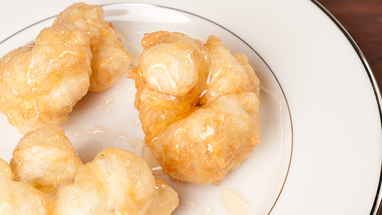
Dough
Mix the Dough
- 1 package dry yeast (2 1/4 teaspoons)
- 1 1/3 cups warm water
- 3 cups all-purpose flour
- 2 eggs, well beaten
- Oil for deep frying
- 1/2 teaspoon salt
- 1 tablespoon olive oil
- 3 cups Honey
- 1/4 cup of water
- Cinnamon and powdered sugar
Mix the Dough
- Dissolve the yeast into 1/3 cup of the warm water and let sit for 10 minutes. You should see little bubbles after a few minutes, proving the yeast is fresh and working.
- Place the flour into a medium bowl. Stir in the yeasted water, the beaten eggs, salt and olive oil into the flour all at once. Gradually add the remaining water to make a slightly sticky dough.
- Cover and allow to rise in a warm spot for at least 1 hour until the mixture doubles in bulk.
- Mix the honey and water in a medium saucepan and bring to a hard boil. Reduce the heat to low. Simmer for 5 minutes and then turn down the heat to very low so it stays warm.
- In a large deep skillet (or electric frying pan) cover the pan with a mix of vegetable oil and a small amount of olive oil, about 1" deep.
- Heat until it is hot enough for a drop of water to spatter.
- Dip a tablespoon into oil to coat it. Dip out a about a teaspoons worth of batter and drop it into hot oil. You can fry several at once as long as you don't crowd them in the pan.
- As they fry turn them several times until they puff up and become golden, about 8 minutes.
- Line a tray with paper towels. Use a slotted spoon to remove the fritters and drain them on the towels.
- Drizzle with hot honey syrup and if desired dust with powdered sugar and/or cinnamon. Serve warm immediately.
- Enjoy!
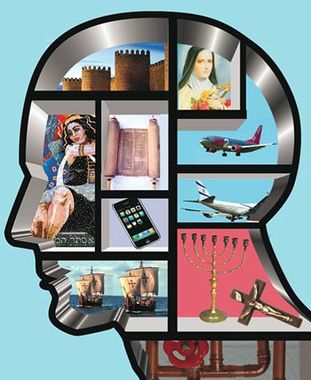 Image: MONTAGE BY KURT HOFFMAN. http://forward.com/culture/105665/thoroughly-modern-marranos/
Image: MONTAGE BY KURT HOFFMAN. http://forward.com/culture/105665/thoroughly-modern-marranos/
Activity #3 Point-Counterpoint: 500 Years Later, Would you Claim Spanish Citizenship?
In 1992, marking the 500th anniversary of the 1492 Expulsion Order, President Chaim Herzog of Israel and Spain's King, Juan Carlos, prayed together in the synagogue of Madrid. Their gesture symbolized reconciliation between their people. Twenty-two years later in 2014, in a dramatic gesture, Spain invited the descendants of the exiled Jews to become Spanish again. Under a law approved by Spain's government, it granted Spanish citizenship to descendants of Jews expelled in 1492. A recent amendment to the law would let Sephardic Jews keep their current citizenship as well. Spain says it wants to rectify what it calls a "historic mistake."
What would you do? After the expulsion, the Sephardic leadership imposed an informal ban forbidding Jews from ever again living in Spain. Specifically because the earlier time in that country had been so happy, the Jews regarded the expulsion as a terrible betrayal. They have remembered it ever since with particular bitterness.
Articles About Spain's Offer of Citizenship
http://articles.latimes.com/2014/mar/27/world/la-fg-spain-jews-20140327
500 Years After Expulsion, Spain Reaches Out to Jews
http://www.npr.org/sections/parallels/2014/12/25/371866778/after-522-years-spain-seeks-to-make-amends-for-expulsion-of-jew
Like ships passing in the night, there will be no clash, no conflict and ultimately, no debate.
Rebuttal, like argumentation, is one of the foundations of debate. What is rebuttal then?
It is a speaker saying that an opponent's argument is not valid and showing why it is not valid.
If argument is about building logic links in a case, then rebuttal is about the breaking of these links."
http://debateable.org/debate-topics/rebuttals
Activity inspired by: Mel Silberman, Active Learning: 101 Strategies to Teach Any Subject, 1996
In 1992, marking the 500th anniversary of the 1492 Expulsion Order, President Chaim Herzog of Israel and Spain's King, Juan Carlos, prayed together in the synagogue of Madrid. Their gesture symbolized reconciliation between their people. Twenty-two years later in 2014, in a dramatic gesture, Spain invited the descendants of the exiled Jews to become Spanish again. Under a law approved by Spain's government, it granted Spanish citizenship to descendants of Jews expelled in 1492. A recent amendment to the law would let Sephardic Jews keep their current citizenship as well. Spain says it wants to rectify what it calls a "historic mistake."
What would you do? After the expulsion, the Sephardic leadership imposed an informal ban forbidding Jews from ever again living in Spain. Specifically because the earlier time in that country had been so happy, the Jews regarded the expulsion as a terrible betrayal. They have remembered it ever since with particular bitterness.
- This activity called Point-Counterpoint stimulates discussion about complex and controversial matters. It is similar to a debate, but less formal.
- Select grade appropriate sections from one or more of the news articles below about Spain's reconciliation with Sephardic Jews, and the law to grant them citizenship. Read the excerpts aloud and clarify vocabulary and concepts.
Articles About Spain's Offer of Citizenship
http://articles.latimes.com/2014/mar/27/world/la-fg-spain-jews-20140327
500 Years After Expulsion, Spain Reaches Out to Jews
http://www.npr.org/sections/parallels/2014/12/25/371866778/after-522-years-spain-seeks-to-make-amends-for-expulsion-of-jew
- Divide the class into two groups. Ask them all to imagine that they are of Sephardic descent. Of course, some of the students will have Sephardic ancestors. One group will debate the point, "If I was of Sephardic descent YES, I would claim Spanish citizenship. The other group will debate the point --NO! If I was of Sephardic descent I would not want to apply to be e a Spanish citizen. Remind them that the law allows dual citizenship.
- Have the groups divide into smaller groups on each side and review the article excerpts. Each small group should make a list of all their points in arguing their side, even if it is not their actual opinion. Have them imagine what the other group will say. Write out 3 or 4 counterarguments on index cards.
- Line up the two opposing groups so they are facing each other. Bring a ball or beanbag and throw it to a student. After they catch it they need to briefly argue their point. When they conclude they throw it to someone on the opposing side who must rebut the persons argument.
Like ships passing in the night, there will be no clash, no conflict and ultimately, no debate.
Rebuttal, like argumentation, is one of the foundations of debate. What is rebuttal then?
It is a speaker saying that an opponent's argument is not valid and showing why it is not valid.
If argument is about building logic links in a case, then rebuttal is about the breaking of these links."
http://debateable.org/debate-topics/rebuttals
- Conclude the activity by comparing and contrasting the different sides of the issue. Discuss what side they would have preferred to be arguing.
- This format can also be used to understand the complex challenges the conversos felt by having students debate whether or not they would have converted to Christianity if they were living in Spain in the years prior to expulsion.
Activity inspired by: Mel Silberman, Active Learning: 101 Strategies to Teach Any Subject, 1996
